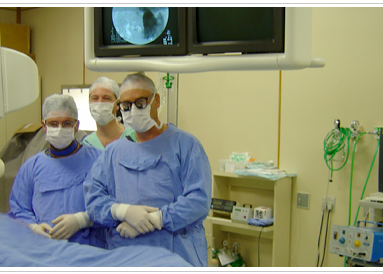Aortic Aneurysm Most Frequent Questions
Most Frequent Questions
How is the aneurysm detected?
The aortic aneurysms are usually detected fortuitly during an abdominal palpation by a physician or, more often, by imaging exams performed for another objective, for example: a male performs an abdominal echography to evaluate the prostate gland and an aneurysm is detected, or a female performs an echography to evaluate stones in the gallbladder or ovaries and verifies the presence of the aneurysm. The aneurysms of abdominal aorta are often identified by an abdominal echography, as they are silent. On the other hand, the most frequent form of detecting aneurysms of thoracic aorta is by a thoracic Rx.
Does every aortic aneurysm need to be treated with surgery?
No. The rupture probability is low in small aneurysms, smaller than 4 cm of diameter; then many times the chosen option is to treat the high arterial pressure and to closely follow the aneurysm to see if it grows. Many small aneurysms stay in that stage for years or decades. Each patient has a different evolution and, therefore, an abdominal echography (and, in some cases, a tomography) must be performed every 6 months for a better evaluation. The rupture chance increases once the aneurysm achieves a larger diameter, and then we must decide on what is the best treatment option: conventional surgery or endoprosthesis.
Does the aneurysm surgery have many risks?
When performed openly, with incisions on thorax or abdomen, the traditional surgery is a large-sized procedure. It presents a risk that ranges from 4% to 10% of mortality for aneurysms of abdominal aorta and up to 20% for aneurysms of thoracic aorta or thoracoabdominal aneurysms. There is also risk of complications in other organs or systems, such as lungs and kidneys, for example. Anyway, it is still a safe and very used procedure, presenting the advantage of long-term follow-up, as the procedure has several decades of existence. The endovascular surgery presents a lower risk during the procedure by being less invasive.

How does the endovascular technique (endoprosthesis) work?
A catheter is inserted in the femoral artery at the groin, under radioscopy (Rx film), with the endoprosthesis closed inside it, until reaching the aneurysm site. The endoprosthesis is released in such place, fixating itself inside the aorta, excluding the aneurysm from the circulation, and reinforcing the weak wall.
As this procedure is well less invasive than the open surgery, it presents lower surgical risk. However, it is not exempt of issues. As it is a relatively new procedure, the long-term results are not well-known. Leakages (endoleaks) might occur and can be usually treated as new endoprosthesis. The hospitalization time is shorter (3 days in average), and the recovery is faster.
For how much time has Clínica Saadi been using the endoprosthesis, how many cases has it been treated, and what are the results?
We have started our expertise in July, 2003, and we have performed more than 350 endovascular procedures up to December, 2010.
Can all aneurysms be treated by endovascular route?
No. We are very careful in the preoperatory evaluation because the results of the endovascular treatment are directly linked to a proper patient selection. When in doubt, in cases of aneurysms with unfavorable anatomy, with short and much angulated neck and very calcified and angulated or thin arteries, we must not insist with the indication and we have to choose the open surgery.
Is general anesthesia necessary for the endovascular surgery?
No. Most cases can be performed with regional anesthesia (peridural or epidural) and, in some cases, even with local anesthesia.
How does the team work? Which are the physicians acting?
We work with a multidisciplinary group that, besides experienced cardiovascular surgeons, has a vascular radiologist, an interventionist cardiologist, intensivist cardiologists, and anesthetists trained for aortic surgery. In our opinion, the gathering of forces of different specialties is pivotal for the highest benefit for the patient. Fortunately, we adopt a cooperative position instead of a competition among specialties.

